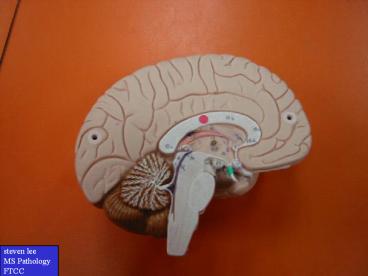steven%20lee - PowerPoint PPT Presentation
Title:
steven%20lee
Description:
Each superior colliculus receives visual input. Inferior colliculi ... Cerebral (mesencephalic) aqueduct. infundibulum. steven lee. MS Pathology. FTCC. steven lee ... – PowerPoint PPT presentation
Number of Views:165
Avg rating:3.0/5.0
Title: steven%20lee
1
steven lee MS Pathology FTCC
2
3 divisions of the brain make up the brain stem
Midbrain mesencephalon
Pons
Medulla oblongate attaches to the spinal
cord located just above foramen magnum
steven lee MS Pathology FTCC
3
sulcus
gyrus
steven lee MS Pathology FTCC
4
steven lee MS Pathology FTCC
5
steven lee MS Pathology FTCC
6
sulcus
gyrus
steven lee MS Pathology FTCC
7
steven lee MS Pathology FTCC
8
Pineal body (gland) Endocrine structure that
secretes the hormone melatonine
Massa intermedia A projection of gray matter
Corpora quadrigemina Superior colliculi Each
superior colliculus receives visual
input Inferior colliculi The inferior colliculus
receives auditory data
steven lee MS Pathology FTCC
9
Corpus callosum thick band of white matter that
connects the two cerebral hemispheres.
Mamillary body
Optic chiasm
steven lee MS Pathology FTCC
10
steven lee MS Pathology FTCC
cerebrum
Cerebral (mesencephalic) aqueduct
Corpus collosum
fornix
infundibulum
midbrain
pons
4th ventricle
pituitary
11
steven lee MS Pathology FTCC
12
steven lee MS Pathology FTCC
13
steven lee MS Pathology FTCC
14
Occipital lobe
Parietal lobe
Frontal lobe
Temporal lobe
steven lee MS Pathology FTCC
15
steven lee MS Pathology FTCC
16
steven lee MS Pathology FTCC
17
steven lee MS Pathology FTCC
18
CEREBRUM Largest part of brain. Divided into left
and right hemispheres by longitudinal
fissure. Controls voluntary movements,
coordinates mental activity and is the center
for all conscious living.
steven lee MS Pathology FTCC
19
Cerebellum is the second largest part of the
brain. Functions as a processing center for
coordination of muscular movements and balance.
Also processes sensory information for use by
motor systems.
steven lee MS Pathology FTCC
20
steven lee MS Pathology FTCC
21
Cerebellum performs functions related to the
control of skeletal muscles.
steven lee MS Pathology FTCC
22
steven lee MS Pathology FTCC
23
steven lee MS Pathology FTCC
24
steven lee MS Pathology FTCC































